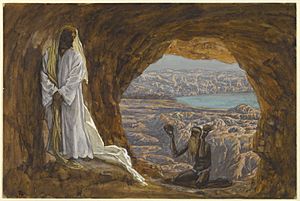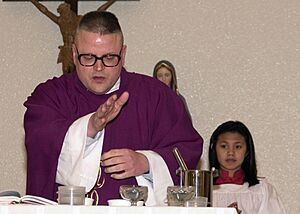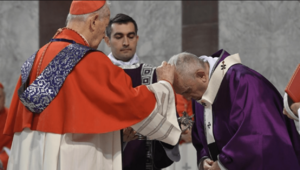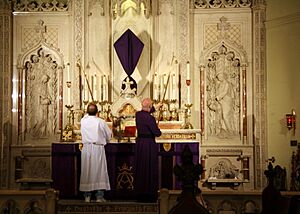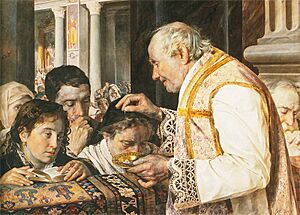Ash Wednesday facts for kids
Quick facts for kids Ash Wednesday |
|
|---|---|
|
A cross marked in ash on a worshiper's forehead
|
|
| Observed by | Many Western Christians |
| Type | Christian |
| Observances | Holy Mass, Divine Service, Holy Qurbana, Service of worship Fasting and abstinence Placing of ashes on the head |
| Date | 46 days before Easter Sunday |
| 2024 date | 14 February |
| 2025 date | 5 March |
| 2026 date | 18 February |
| 2027 date | 10 February |
| Frequency | Annual |
| Related to | Shrove Tuesday/Mardi Gras Shrovetide/Carnival Lent Easter Eastertide |
Ash Wednesday is a special day of prayer and fasting for many Western Christian churches. It happens right after Shrove Tuesday and marks the very first day of Lent. Lent is a seven-week period of prayer, fasting, and giving to charity that leads up to Easter.
Christians from many churches observe Ash Wednesday. These include the Catholic, Lutheran, Moravian, and Anglican (also called Episcopalian) churches. Some United Protestant churches, as well as certain Reformed, Baptist, Methodist, and Nazarene traditions, also observe it.
On Ash Wednesday, many Christians begin Lent by marking a Lenten calendar. They might also pray a special Lenten daily devotional or choose to give up something they enjoy, called a Lenten sacrifice. They usually keep this sacrifice until Eastertide arrives.
Many people go to special Ash Wednesday church services. During these services, churchgoers receive ash on their foreheads or the top of their heads. Wearing ashes has been a sign of saying sorry for mistakes since biblical times. The ashes are often placed in the sign of the cross, showing that the person is a follower of Jesus. Ash Wednesday gets its name from this practice. When the ashes are placed, people often hear words like "Repent, and believe in the Gospel" or "Remember that you are dust, and to dust you shall return." The ashes come from burning palm leaves from the previous year's Palm Sunday celebrations.
Contents
Who Observes Ash Wednesday?
Churches That Observe This Day
Many Christian groups in Western Christianity observe Ash Wednesday. This includes Latin Church Catholics, Lutherans, Anglicans, and Moravians. Churches in the United Protestant tradition, like the Church of North India, also honor Ash Wednesday.
Some Baptists, many Methodists, and some Mennonites also observe Ash Wednesday. The Metropolitan Community Churches and the Community of Christ observe it too.
Historically, Reformed churches did not observe Ash Wednesday or Lent. This was due to their regulative principle of worship, which means they only do what the Bible specifically tells them to do in worship. However, since the mid-1900s, many Reformed churches, including some Congregationalist, Continental Reformed, and Presbyterian churches, have started to observe both Ash Wednesday and Lent. For example, the Reformed Church in America sees Ash Wednesday as a day for "prayer, fasting, and repentance."
Churches That Do Not Observe This Day
The Eastern Orthodox Church generally does not observe Ash Wednesday. Their Great Lent begins on Clean Monday instead. However, a small number of Orthodox Christians who follow the Western Rite do observe Ash Wednesday. Their date for it might be different because it depends on the Orthodox calculation of Pascha.
How Ash Wednesday is Observed
Fasting and Giving Things Up
Many churches that observe Lent focus on making a Lenten sacrifice. This means giving up something, as well as fasting and avoiding certain foods during Lent, especially on Ash Wednesday. The First Council of Nicaea talked about Lent as a 40-day period of fasting before Easter.
When people start a Lenten sacrifice on Ash Wednesday (like giving up watching TV), they often pray for strength to keep it up throughout Lent. In some places, Christians used to fast all day until evening. At sunset, Western Christians would traditionally break this fast, which was sometimes called the Black Fast. In countries like India and Pakistan, many Christians still fast until sunset on Ash Wednesday and Good Friday.
Among Catholics, Ash Wednesday involves fasting, abstinence from meat, and repentance. On Ash Wednesday and Good Friday, Roman Catholics between 18 and 59 years old, if healthy, can have one full meal and two smaller meals. These two smaller meals together should not be as big as the full meal. Ash Wednesday and all Fridays during Lent are also days to avoid meat (mammals and fowl).
Many Lutheran churches teach their members to fast on Ash Wednesday. Some Lutherans choose to continue fasting throughout Lent, especially on Good Friday. A Lutheran guide suggests "Fast on Ash Wednesday and Good Friday with only one simple meal during the day, usually without meat."
In the Church of England, all forty days of Lent are considered days of fasting. Fridays are also days to avoid certain foods. A prayer book for Anglicans suggests "Fasting" means having a light breakfast, one full meal, and one half-meal on the forty days of Lent. It defines abstinence as not eating meat on all Fridays of the Church Year, except during Christmastide.
In the Methodist tradition, John Wesley's sermons emphasize the importance of the Lenten fast, which starts on Ash Wednesday. The United Methodist Church says there is a strong biblical reason for fasting during the 40 days of Lent. Jesus himself fasted for 40 days and 40 nights. A Methodist minister explained that fasting means "I'm not skipping a meal because in place of that meal, I'm dining with God."
Members of the Moravian Church can choose to fast during Lent. They might also make a Lenten sacrifice as a way to show their repentance.
When Ash Wednesday Happens
Ash Wednesday is always 46 days before Easter Sunday. Easter is a moveable feast because its date changes each year. It is the Sunday after the first full moon that occurs on or after March 21.
Lent lasts for 40 days, not counting Sundays. So, the entire season is 46 days long. Lent begins on Ash Wednesday and ends on Holy Saturday for many churches. In the Catholic Church, it ends at the start of the Easter Triduum on the evening of Holy Thursday.
Ash Wednesday has sometimes happened on Valentine's Day (February 14). This happened in 1923, 1934, 1945, 2018, and 2024. It will happen again in 2029.
The 40-day period of Lent is a reminder of Jesus's time in the desert. He spent 40 days there fasting and praying, and he was tempted. This also reminds people of the 40 days Moses fasted after the Golden calf incident.
Receiving Ashes
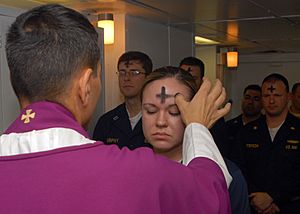
Ashes are placed on the heads of Christians on Ash Wednesday. This is done either by sprinkling them over the head or, more commonly in English-speaking countries, by marking a visible cross on the forehead. The traditional words said when placing the ashes are: "Remember, man, that thou art dust, and to dust thou shalt return." This reminds people that they are human and will eventually die, encouraging them to repent.
In 1969, a new phrase was introduced: "Repent, and believe in the Gospel." This phrase is now often used first. The ashes are usually made from burning palm leaves from the previous year's Palm Sunday.
Different ways of placing ashes are used. The two most common are making a cross on the forehead and sprinkling ashes over the top of the head. In the Lutheran Churches, ashes are usually placed on the forehead as a cross.
In the Church of England, the Ash Wednesday service includes "The Imposition of Ashes." The Pope, who is the Bishop of Rome, traditionally takes part in a procession and has ashes sprinkled on his head, not smudged on his forehead. He also places ashes on others in the same way.
While only a priest or deacon can bless the ashes, other church members can help place the ashes on people's heads. People also often take blessed ashes home to place on family members who could not attend the service.
The Catholic Church allows anyone to receive the ashes, even those who are not Catholic or baptized. They do not limit the distribution of ashes to church buildings. Sometimes, services are held in places like shopping centers or nursing homes.
Many Christians choose to keep the ash mark visible on their forehead throughout the day. This is not a strict rule, but some Christian leaders suggest it as a public way to show their faith.
Ashes to Go
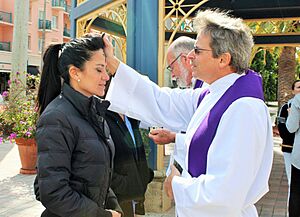
Since 2007, some Christian churches in the United States have started "Ashes to Go." This is where clergy go to public places like city centers, sidewalks, and railroad stations. They offer ashes to people passing by, even those waiting in their cars. This practice is also a way to share their faith.
Anglicans and Catholics in places like Sunderland, UK, have offered Ashes to Go together. This shows a good example of different churches working together. The Catholic Student Association of Kent State University has offered ashes to students on campus.
In 2013, churches in the United States, United Kingdom, Canada, and South Africa participated in Ashes to Go. Many of these churches were Episcopal, but there were also Methodist, Presbyterian, and Catholic churches involved.
Special Services and Customs
A traditional Ash Wednesday church service often includes Psalm 51 (a prayer of confession) and other prayers. The Anglican church's traditional service, called A Commination, includes these prayers but not the ashes ceremony itself. The Catholic Church's traditional service includes the blessing and distribution of ashes.
In the mid-1500s, the first Book of Common Prayer in the Church of England removed the ashes ceremony. It was replaced with the Commination Office. This service involved reading biblical curses against sinners, and people would respond with "Amen." This was meant to remind people of the need for public repentance.
In some churches, especially those with less formal traditions, other practices are used. For example, people might write a sin they want to confess on a small card. These cards are then brought to the altar table and burned.
In the Victorian era, theatres in England did not put on costumed shows on Ash Wednesday. They offered other entertainment instead, as required by the Church of England.
In Iceland, children have a unique custom. They "pin small bags of ashes on the back of some unsuspecting person." They also dress up in costumes and sing songs to get candy.
In Hungary, if someone in a village did not receive ashes, people would "share their blessing" by rubbing their foreheads together. The Csángó people of Moldova even cover pots with ashes for good luck. Dancing was forbidden, so children played special dancing and ball games.
Why Ashes Are Used
Biblical Meaning of Ashes
Ashes were used in ancient times to show sadness or to say sorry for mistakes.
The Bible tells a story in Jonah 3. After the prophet Jonah warned the people of Nineveh, they repented. They fasted and wore ashes and sackcloth (a rough cloth). Because of this, God spared them.
When Tamar was hurt, "she sprinkled ashes on her head, tore her robe, and with her face buried in her hands went away crying" (2 Samuel 13:19). This shows ashes were used to express deep sorrow. Ashes can also symbolize the old, sinful self dying and returning to dust. In Job 42:5–6, Job says to God: "I abhor myself, and repent in dust and ashes."
The prophet Jeremiah called for repentance by saying: "O daughter of my people, gird on sackcloth, roll in the ashes" (Jer 6:26). The prophet Daniel prayed to God with "fasting, sackcloth, and ashes" (Daniel 9:3). Before the New Testament, the Maccabees used ashes when preparing for battle: "That day they fasted and wore sackcloth; they sprinkled ashes on their heads and tore their clothes" (1 Maccabees 3:47).
Other Bible books also mention the use of ashes by Jews. Jesus himself spoke of the practice in Matthew 11:21 and Luke 10:13.
Christian Use of Ashes Through History
Christians continued to use ashes as an outward sign of repentance. Early Christian writers like Tertullian (around 160–225 AD) said that confessing sins should involve lying in sackcloth and ashes. The historian Eusebius (around 260–340 AD) wrote about a person who covered himself with ashes when asking to be allowed back into the church.
By the end of the 900s, it was common in Western Europe for all Christians to receive ashes on the first day of Lent. In 1091, Pope Urban II ordered this custom to be used in Rome as well. Soon after, the day became known as "Feria Quarta Cinerum," or "Ash Wednesday."
Public penance for serious sinners used to last throughout Lent. On the first day, they would be sprinkled with ashes and wear sackcloth. When this practice of public penance stopped, the beginning of Lent became a general time of repentance for everyone. This was marked by sprinkling ashes on everyone's heads. This practice is found in church books from the late 700s.
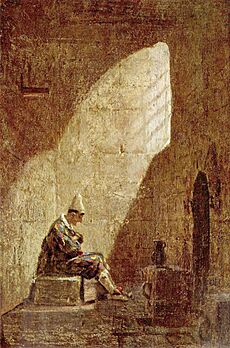
After the Protestant Reformation, the ashes ceremony was not forbidden in the Church of England. It was even required under King Henry VIII in 1538 and King Edward VI in 1550. However, it became less common in many areas after 1600.
In the 1900s, the practice of using ashes was encouraged again in Protestant churches, including the Methodist Church. It has also been adopted by Anabaptist and Reformed churches, and some other Christian groups.
The Eastern Orthodox churches generally do not observe Ash Wednesday. However, some Western Orthodox churches do. In this tradition, ashes can be given outside of a church service.
In the Ambrosian Rite, ashes are blessed and placed on people's heads on the Sunday after what is called Ash Wednesday elsewhere. This Sunday starts Lent in that tradition.
Dates of Ash Wednesday
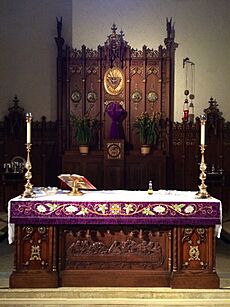
Ash Wednesday is always 46 days before Easter Sunday. Easter is a moveable feast because its date changes each year. It is calculated based on the cycles of the moon.
The earliest Ash Wednesday can be is February 4. This happened in 1598, 1693, 1761, and 1818. It will next happen in 2285. The latest Ash Wednesday can be is March 10. This happened in 1666, 1734, 1886, and 1943. It will next happen in 2038.
Since the Gregorian calendar was introduced in 1582, Ash Wednesday has never fallen on a Leap Year Day (February 29). However, it will happen for the first time in 2096.
National No Smoking Day
In the Republic of Ireland, Ash Wednesday is also National No Smoking Day. This date was chosen because quitting smoking fits with the idea of giving up something for Lent. It also connects to the idea of ash and smoking. In the United Kingdom, No Smoking Day was first held on Ash Wednesday in 1984. Now, it is always on the second Wednesday in March.
Images for kids
-
Imposition of ashes at Saint-Pierre-le-Jeune Catholic Church, Strasbourg, 2014
-
A Methodist pastor distributing ashes to confirmands kneeling at the chancel rails, 2016
See also
 In Spanish: Miércoles de Ceniza para niños
In Spanish: Miércoles de Ceniza para niños


